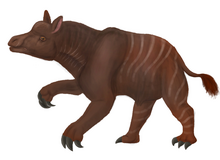| Tylocephalonyx Temporal range: Miocene,
| |
|---|---|

| |
| Life restoration | |
| Scientific classification | |
| Domain: | Eukaryota |
| Kingdom: | Animalia |
| Phylum: | Chordata |
| Class: | Mammalia |
| Order: | Perissodactyla |
| Family: | †Chalicotheriidae |
| Subfamily: | †Schizotheriinae |
| Genus: | †Tylocephalonyx Coombs, 1979 |
| Species: | †T. skinneri
|
| Binomial name | |
| †Tylocephalonyx skinneri Coombs, 1979
| |
Tylocephalonyx (Greek: "knob" (tylos), "head" (kephalos), "claw/hoof" (onyx)[2]) is an extinct chalicothere from the Miocene of North America.
